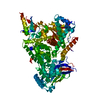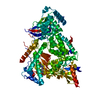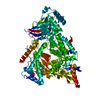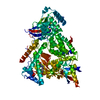Entry Database : PDB / ID : 8exvTitle Crystal structure of PI3K-alpha in complex with compound 32 Phosphatidylinositol 4,5-bisphosphate 3-kinase catalytic subunit alpha isoform Keywords / / / / / Function / homology Function Domain/homology Component
/ / / / / / / / / / / / / / / / / / / / / / / / / / / / / / / / / / / / / / / / / / / / / / / / / / / / / / / / / / / / / / / / / / / / / / / / / / / / / / / / / / / / / / / / / / / / / / / / / / / / / / / / / / / / / / / / / / / / / / / / / / / / / / / / / / / / / / / / / / / / / / / / / / / Biological species Homo sapiens (human)Method / / / Resolution : 2.48 Å Authors Kiefer, J.R. / Eigenbrot, C. / Staben, S.T. / Hanan, E.J. / Wallweber, H.J.A. / Ultsch, M. / Braun, M.G. / Friedman, L.S. / Purkey, H.E. Funding support 1items Organization Grant number Country Not funded
Journal : J.Med.Chem. / Year : 2022Title : Discovery of GDC-0077 (Inavolisib), a Highly Selective Inhibitor and Degrader of Mutant PI3K alpha.Authors: Hanan, E.J. / Braun, M.G. / Heald, R.A. / MacLeod, C. / Chan, C. / Clausen, S. / Edgar, K.A. / Eigenbrot, C. / Elliott, R. / Endres, N. / Friedman, L.S. / Gogol, E. / Gu, X.H. / Thibodeau, R. ... Authors : Hanan, E.J. / Braun, M.G. / Heald, R.A. / MacLeod, C. / Chan, C. / Clausen, S. / Edgar, K.A. / Eigenbrot, C. / Elliott, R. / Endres, N. / Friedman, L.S. / Gogol, E. / Gu, X.H. / Thibodeau, R.H. / Jackson, P.S. / Kiefer, J.R. / Knight, J.D. / Nannini, M. / Narukulla, R. / Pace, A. / Pang, J. / Purkey, H.E. / Salphati, L. / Sampath, D. / Schmidt, S. / Sideris, S. / Song, K. / Sujatha-Bhaskar, S. / Ultsch, M. / Wallweber, H. / Xin, J. / Yeap, S. / Young, A. / Zhong, Y. / Staben, S.T. History Deposition Oct 25, 2022 Deposition site / Processing site Revision 1.0 Nov 30, 2022 Provider / Type Revision 1.1 Dec 14, 2022 Group / Category / citation_authorItem _citation.journal_abbrev / _citation.pdbx_database_id_DOI ... _citation.journal_abbrev / _citation.pdbx_database_id_DOI / _citation.pdbx_database_id_PubMed / _citation.title Revision 1.2 Jan 4, 2023 Group / Category / citation_authorItem _citation.journal_volume / _citation.page_first ... _citation.journal_volume / _citation.page_first / _citation.page_last / _citation_author.identifier_ORCID
Show all Show less
 Open data
Open data Basic information
Basic information Components
Components Keywords
Keywords CELL CYCLE /
CELL CYCLE /  PI3K /
PI3K /  drug /
drug /  inhibitor /
inhibitor /  cancer /
cancer /  oncology
oncology Function and homology information
Function and homology information regulation of cellular respiration /
regulation of cellular respiration /  phosphatidylinositol 3-kinase complex /
phosphatidylinositol 3-kinase complex /  anoikis / Nephrin family interactions / 1-phosphatidylinositol-4-phosphate 3-kinase activity / Costimulation by the CD28 family / vascular endothelial growth factor signaling pathway / 1-phosphatidylinositol-4,5-bisphosphate 3-kinase activity / MET activates PI3K/AKT signaling / PI3K/AKT activation /
anoikis / Nephrin family interactions / 1-phosphatidylinositol-4-phosphate 3-kinase activity / Costimulation by the CD28 family / vascular endothelial growth factor signaling pathway / 1-phosphatidylinositol-4,5-bisphosphate 3-kinase activity / MET activates PI3K/AKT signaling / PI3K/AKT activation /  phosphatidylinositol-4,5-bisphosphate 3-kinase / phosphatidylinositol 3-kinase complex, class IA /
phosphatidylinositol-4,5-bisphosphate 3-kinase / phosphatidylinositol 3-kinase complex, class IA /  phosphatidylinositol 3-kinase / relaxation of cardiac muscle / phosphatidylinositol-3-phosphate biosynthetic process / 1-phosphatidylinositol-3-kinase activity / negative regulation of macroautophagy / Signaling by ALK / PI-3K cascade:FGFR3 / Erythropoietin activates Phosphoinositide-3-kinase (PI3K) / protein kinase activator activity / response to dexamethasone / PI-3K cascade:FGFR2 / PI-3K cascade:FGFR4 / PI-3K cascade:FGFR1 / CD28 dependent PI3K/Akt signaling / Synthesis of PIPs at the plasma membrane / phosphatidylinositol phosphate biosynthetic process / PI3K events in ERBB2 signaling / Signaling by ALK fusions and activated point mutants / negative regulation of anoikis / RET signaling / regulation of multicellular organism growth /
phosphatidylinositol 3-kinase / relaxation of cardiac muscle / phosphatidylinositol-3-phosphate biosynthetic process / 1-phosphatidylinositol-3-kinase activity / negative regulation of macroautophagy / Signaling by ALK / PI-3K cascade:FGFR3 / Erythropoietin activates Phosphoinositide-3-kinase (PI3K) / protein kinase activator activity / response to dexamethasone / PI-3K cascade:FGFR2 / PI-3K cascade:FGFR4 / PI-3K cascade:FGFR1 / CD28 dependent PI3K/Akt signaling / Synthesis of PIPs at the plasma membrane / phosphatidylinositol phosphate biosynthetic process / PI3K events in ERBB2 signaling / Signaling by ALK fusions and activated point mutants / negative regulation of anoikis / RET signaling / regulation of multicellular organism growth /  insulin receptor substrate binding /
insulin receptor substrate binding /  Interleukin-3, Interleukin-5 and GM-CSF signaling / PI3K Cascade /
Interleukin-3, Interleukin-5 and GM-CSF signaling / PI3K Cascade /  intercalated disc / positive regulation of TOR signaling / endothelial cell migration / RAC2 GTPase cycle / GAB1 signalosome / Role of phospholipids in phagocytosis / Role of LAT2/NTAL/LAB on calcium mobilization / adipose tissue development / Interleukin receptor SHC signaling / positive regulation of lamellipodium assembly /
intercalated disc / positive regulation of TOR signaling / endothelial cell migration / RAC2 GTPase cycle / GAB1 signalosome / Role of phospholipids in phagocytosis / Role of LAT2/NTAL/LAB on calcium mobilization / adipose tissue development / Interleukin receptor SHC signaling / positive regulation of lamellipodium assembly /  phagocytosis / Signaling by PDGFRA transmembrane, juxtamembrane and kinase domain mutants / Signaling by PDGFRA extracellular domain mutants /
phagocytosis / Signaling by PDGFRA transmembrane, juxtamembrane and kinase domain mutants / Signaling by PDGFRA extracellular domain mutants /  energy homeostasis / Signaling by FGFR4 in disease / Signaling by FLT3 ITD and TKD mutants / cardiac muscle contraction / Signaling by FGFR3 in disease / GPVI-mediated activation cascade / Tie2 Signaling / Signaling by FGFR2 in disease / RAC1 GTPase cycle / T cell costimulation / response to muscle stretch / Signaling by FLT3 fusion proteins / FLT3 Signaling / Signaling by FGFR1 in disease / Downstream signal transduction / insulin-like growth factor receptor signaling pathway / Signaling by phosphorylated juxtamembrane, extracellular and kinase domain KIT mutants / response to activity / liver development / phosphatidylinositol 3-kinase/protein kinase B signal transduction / Regulation of signaling by CBL / cellular response to glucose stimulus / positive regulation of smooth muscle cell proliferation /
energy homeostasis / Signaling by FGFR4 in disease / Signaling by FLT3 ITD and TKD mutants / cardiac muscle contraction / Signaling by FGFR3 in disease / GPVI-mediated activation cascade / Tie2 Signaling / Signaling by FGFR2 in disease / RAC1 GTPase cycle / T cell costimulation / response to muscle stretch / Signaling by FLT3 fusion proteins / FLT3 Signaling / Signaling by FGFR1 in disease / Downstream signal transduction / insulin-like growth factor receptor signaling pathway / Signaling by phosphorylated juxtamembrane, extracellular and kinase domain KIT mutants / response to activity / liver development / phosphatidylinositol 3-kinase/protein kinase B signal transduction / Regulation of signaling by CBL / cellular response to glucose stimulus / positive regulation of smooth muscle cell proliferation /  regulation of protein phosphorylation / Constitutive Signaling by EGFRvIII / Signaling by ERBB2 ECD mutants / epidermal growth factor receptor signaling pathway / Signaling by ERBB2 KD Mutants / Signaling by SCF-KIT /
regulation of protein phosphorylation / Constitutive Signaling by EGFRvIII / Signaling by ERBB2 ECD mutants / epidermal growth factor receptor signaling pathway / Signaling by ERBB2 KD Mutants / Signaling by SCF-KIT /  platelet activation / VEGFA-VEGFR2 Pathway / cellular response to insulin stimulus / glucose metabolic process / Constitutive Signaling by Aberrant PI3K in Cancer
platelet activation / VEGFA-VEGFR2 Pathway / cellular response to insulin stimulus / glucose metabolic process / Constitutive Signaling by Aberrant PI3K in Cancer
 Homo sapiens (human)
Homo sapiens (human) X-RAY DIFFRACTION /
X-RAY DIFFRACTION /  SYNCHROTRON /
SYNCHROTRON /  MOLECULAR REPLACEMENT / Resolution: 2.48 Å
MOLECULAR REPLACEMENT / Resolution: 2.48 Å  Authors
Authors Citation
Citation Journal: J.Med.Chem. / Year: 2022
Journal: J.Med.Chem. / Year: 2022 Structure visualization
Structure visualization Molmil
Molmil Jmol/JSmol
Jmol/JSmol Downloads & links
Downloads & links Download
Download 8exv.cif.gz
8exv.cif.gz PDBx/mmCIF format
PDBx/mmCIF format pdb8exv.ent.gz
pdb8exv.ent.gz PDB format
PDB format 8exv.json.gz
8exv.json.gz PDBx/mmJSON format
PDBx/mmJSON format Other downloads
Other downloads https://data.pdbj.org/pub/pdb/validation_reports/ex/8exv
https://data.pdbj.org/pub/pdb/validation_reports/ex/8exv ftp://data.pdbj.org/pub/pdb/validation_reports/ex/8exv
ftp://data.pdbj.org/pub/pdb/validation_reports/ex/8exv


 F&H Search
F&H Search Links
Links Assembly
Assembly
 Components
Components
 Homo sapiens (human) / Gene: PIK3CA / Production host:
Homo sapiens (human) / Gene: PIK3CA / Production host: 
 Spodoptera frugiperda (fall armyworm)
Spodoptera frugiperda (fall armyworm) phosphatidylinositol 3-kinase,
phosphatidylinositol 3-kinase,  phosphatidylinositol-4,5-bisphosphate 3-kinase,
phosphatidylinositol-4,5-bisphosphate 3-kinase,  non-specific serine/threonine protein kinase
non-specific serine/threonine protein kinase Water
Water X-RAY DIFFRACTION / Number of used crystals: 1
X-RAY DIFFRACTION / Number of used crystals: 1  Sample preparation
Sample preparation
 SYNCHROTRON / Site:
SYNCHROTRON / Site:  SSRL
SSRL  / Beamline: BL12-2 / Wavelength: 0.9795 Å
/ Beamline: BL12-2 / Wavelength: 0.9795 Å : 0.9795 Å / Relative weight: 1
: 0.9795 Å / Relative weight: 1  Processing
Processing :
:  MOLECULAR REPLACEMENT
MOLECULAR REPLACEMENT Movie
Movie Controller
Controller



 PDBj
PDBj




















